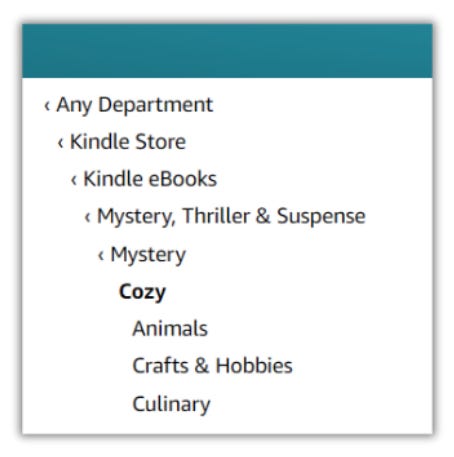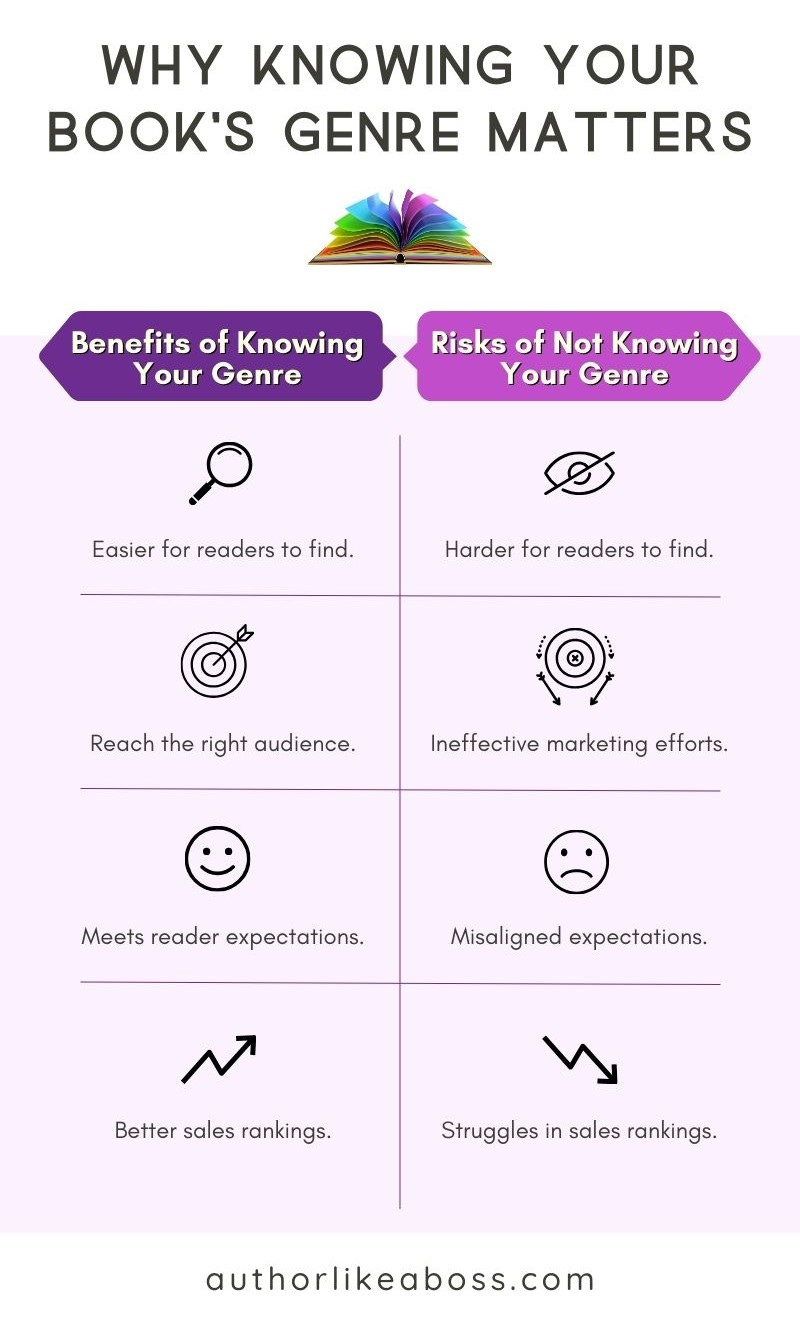The Secret to Determining Your Book’s Genre... and Why It's Important
A Beginner’s Guide to Understanding and Using Genre to Your Advantage
Welcome to the The Reader-Focused Author series! Over the next few weeks, you'll receive fresh emails in your inbox on the topic of BRANDING, each one packed with insider secrets on aligning your books with their perfect audience.
By the time we wrap things up, you'll have an entire book's worth of strategies to analyze your existing works, identify your target readers' desires, and rebrand with a cohesive, compelling vibe that makes sales skyrocket.
The Reader-Focused Author Series — Branding: Align Your Books for Market Success
This is part of a series on about Branding. If you haven’t already, you might be interested in reviewing the other articles in the series:

Why You Need to Know Your Genre
Let's dive right into one of the most crucial aspects of making your book a smashing success. Yep, it's time to talk genre. Now, don’t roll your eyes just yet. I promise this is going to be both enlightening and super helpful for your author journey.
Defining Genre
What is Genre?
So, let’s start with the basics. Genre is like the sorting hat at Hogwarts. Yeah, I see you, Potterheads. It’s that magical categorization that defines the style, content, and form of your writing. Remember stepping into a giant bookstore and getting overwhelmed with the options? Genres help make sense of it all. They encompass your themes, settings, and narrative techniques.
Now, let’s break it down: Imagine genres as different flavors of ice cream. Chocolate, Vanilla, Rocky Road—each one with distinct ingredients and taste profiles, delighting specific groups of people. In the literary world, they help your readers set their expectations and provide you, the glorious author, a framework to create and market your work effectively.
Why Genre Matters
Alright, so why should you care about genre? Isn't your story, your wondrously unique creation, enough on its own? Well, yes—but also no.
Defining your genre serves as the critical bridge between your book and the tribemates who will fall head over heels for it.
Think of your genre as the address on an invitation. Without it, potential readers won't know if they're being invited to a black-tie gala, a backyard BBQ, or a cosplay convention. When you align your book with a specific genre, you’re not only clarifying its identity but also placing it smack dab in the middle of a bustling marketplace where readers are eagerly seeking similar stories. Genre influences every aspect of your book, from cover design and blurb to marketing strategies and reader engagement.
So, you see, understanding your genre is like having a secret map that leads to the hidden treasure chest of devoted readers. Trust me, you want this map.
Sub-Genres and Sub-Sub-Genres
Let's go a notch deeper—welcome to the world of sub-genres and sub-sub-genres! These more precise classifications help target super specific reader interests. It’s like narrowing down a music playlist from ‘Pop’ to ‘90s Pop’ to ‘90s Indie Pop’!
Sub-Genre: A more specific subdivision within a genre. For example, within the vast realm of Romance, sub-genres include ‘Historical Romance,’ ‘Contemporary Romance,’ and ‘Paranormal Romance.’
Sub-Sub-Genre: Even tinier subdivisions. For instance, within ‘Paranormal Romance,’ you can drill down into ‘Shifter Romance,’ ‘Vampire Romance,’ and ‘Witch Romance.’
Examples:
Science Fiction (Genre)
Dystopian (Sub-Genre)
Post-Apocalyptic (Sub-Sub-Genre)
Mystery (Genre)
Cozy Mystery (Sub-Genre)
Amateur Sleuth (Sub-Sub-Genre)
Fantasy (Genre)
Urban Fantasy (Sub-Genre)
Supernatural Detectives (Sub-Sub-Genre)
By getting hyper-specific with these sub-genres, you zero in on your reader's exact tastes and preferences. This is like sending a personalized invitation to a book party they just can't refuse!
How Genres Evolve
Genres aren't set in stone; they're more like clay, constantly reshaped by cultural tastes, societal trends, and technology. What was a niche genre decades ago could be today's blockbuster hit. Remember when dystopian novels were all the rage? (Hunger Games, anyone?) Yeah, those trends ebb and flow like the tides.
Take cyberpunk, for instance. A few decades ago, it was the domain of a select few geeky enthusiasts. But now, thanks to advancements in digital technology and the internet, it's exploded into mainstream popularity. LitRPG is another example—who would've thought merging video game mechanics with traditional storytelling would grow into a thriving genre?
As authors, staying informed about these shifts is crucial to keep our work fresh and relevant. If you're writing a steampunk epic, you better know if your readers are holding on to their goggles and gears, or if they're moving on to sleek, futuristic tech.
Genre vs. Categories on Amazon
Let's clear up a common confusion: genres and Amazon categories. While they might seem interchangeable, they're not quite the same.
Genres define the narrative style and thematic content of your book. Think 'Romance,' 'Thriller,' or 'Fantasy.' These broad classifications help set reader expectations and guide your storytelling.
Amazon categories, on the other hand, are more specific groupings that help organize books for easier discovery. These categories act like sub-genres, providing a more granular classification. For example, within the Romance genre, Amazon categories could include 'Contemporary Romance,' 'Historical Romance,' or 'Paranormal Romance.' It's like zooming in from a 30,000-foot view to street level.
Amazon is at the leading edge of identifying new genres through their category system. They don't necessarily call them genres, but these categories often reflect emerging trends and niche interests in the market. This approach helps authors target their audience more precisely.
Categories Often Align with Sub-Genres
Amazon categories frequently align with sub-genres, creating a detailed and nuanced classification system that benefits both authors and readers.
Here's why this alignment is significant:
1. Precise Targeting: Sub-genres provide a more specific classification within a broader genre, and Amazon categories mirror this precision. For example, within the broader genre of Fantasy, sub-genres like Urban Fantasy, High Fantasy, and Dark Fantasy align with Amazon categories such as 'Urban Fantasy,' 'Epic Fantasy,' and 'Dark Fantasy.' This alignment helps authors target their books more precisely to readers interested in specific types of stories.
2. Meeting Reader Expectations: Readers often search for books within specific sub-genres that match their interests. By aligning your book with the appropriate Amazon category, you meet reader expectations and increase the likelihood of your book being discovered by the right audience. For instance, a reader looking for 'Paranormal Romance' will find your book more easily if it is categorized correctly under that sub-genre.
3. Enhanced Discoverability: Amazon’s search and recommendation algorithms use categories to suggest books to readers. When categories align with sub-genres, it improves the discoverability of your book. A well-categorized book is more likely to appear in search results and recommendations, increasing its visibility and potential sales.
4. Improved Sales Rankings: Books categorized within more specific sub-genres often face less competition than those in broader categories. This can lead to improved sales rankings within those categories. For example, ranking high in 'Cozy Mystery' is more achievable than ranking high in the broader 'Mystery & Thrillers' genre.
5. Niche Marketing: Aligning your book with a specific sub-genre category allows for more effective niche marketing. You can tailor your promotional efforts to the specific interests and preferences of readers within that sub-genre. This targeted approach can lead to higher engagement and better conversion rates.
6. Keeping Up with Trends: Amazon frequently updates its category system to reflect emerging trends and reader preferences. By aligning your book with current sub-genres, you stay relevant and tap into new reader interests. This dynamic system helps you adapt your marketing strategies to stay competitive.
Understanding both genres and Amazon categories is a game-changer for book placement and visibility. When you list your book under the right combination of genre and category, you significantly increase its chances of landing in front of the right readers.
What is Your Book's Genre?
Determining your book's genre is a crucial step in the publishing process. Genre not only sets reader expectations but also guides your marketing strategy, influences cover design, and affects how your book is discovered. To accurately identify your book’s genre, it’s essential to have a working knowledge of genres and sub-genres. Here’s how to get started:
1. Understand the Basics: Genres are broad classifications that describe the overall style and thematic content of your book. Each genre has its own conventions and reader expectations. Here are short descriptions of the most common genres:
Romance: All about love and relationships. Think sparks flying, heart-fluttering moments.
Thriller: Keep them on the edge of their seat with suspense and excitement. Think heart-pounding twists.
Fantasy: Magical worlds, mythical creatures, epic quests. Think otherworldly adventures.
Science Fiction: Futuristic tech, space exploration, alien encounters. Think beyond the stars.
Mystery: Whodunits and puzzle-solving. Think detective work and hidden clues.
Horror: Give them the chills and thrills. Think spooky, creepy, and downright terrifying.
2. Identify Core Themes and Elements: Look at the primary themes and elements in your book. Is it a story about love and relationships, or does it focus on solving a mystery? Does it involve futuristic technology or magical realms? Identifying these core aspects will help you narrow down your genre.
3. Analyze the Setting: The setting of your book can significantly influence its genre. A story set in a magical kingdom is likely to be Fantasy, while one set on a space station may fall under Science Fiction. Consider where and when your story takes place.
4. Consider the Tone and Style: Is your book dark and serious, light-hearted and humorous, or action-packed and suspenseful? The tone and style of your writing can further refine your genre. For example, a dark, psychological narrative may be a Thriller, while a whimsical and adventurous story could be Fantasy.
5. Examine the Plot Structure: Different genres often follow different plot structures. A Romance typically revolves around the development of a romantic relationship, while a Mystery involves solving a puzzle or crime. Understanding your plot structure will help you pinpoint the genre.
6. Use Sub-Genres and Categories: Genres can be further divided into sub-genres, which provide more specific classifications. For instance, within the Romance genre, there are sub-genres like Contemporary Romance, Historical Romance, and Paranormal Romance. On platforms like Amazon, these sub-genres often align with categories, which help target your book to specific reader interests. Knowing these sub-genres is essential for precise classification.
7. Compare with Similar Books: Research books that are similar to yours and see how they are categorized. Look at their genres, sub-genres, and Amazon categories. This comparison can provide insights into where your book fits in the market.
Wrapping Up
Defining your book’s genre is more than just a fun exercise—it's a crucial step in connecting with your ideal readers and setting your book up for success. By understanding genres and sub-genres, you’re equipping yourself with the knowledge to market your book effectively and meet reader expectations.
For those looking to dive even deeper into specific sub-genres, be sure to check out our Genre Reader Profiles. These profiles provide detailed insights into what makes each sub-genre unique, including key themes, reader expectations, and successful examples.
And stay tuned for our next feature: the What is Your Book's Genre? Quiz. This interactive quiz will guide you through a series of questions to help you pinpoint your book's exact genre, making the process both fun and informative.
hugs and happy authoring,
Ella
"Genres aren’t just labels—they’re promises to readers." – Unknown





Thanks for this - looking forward to that interactive quiz too!